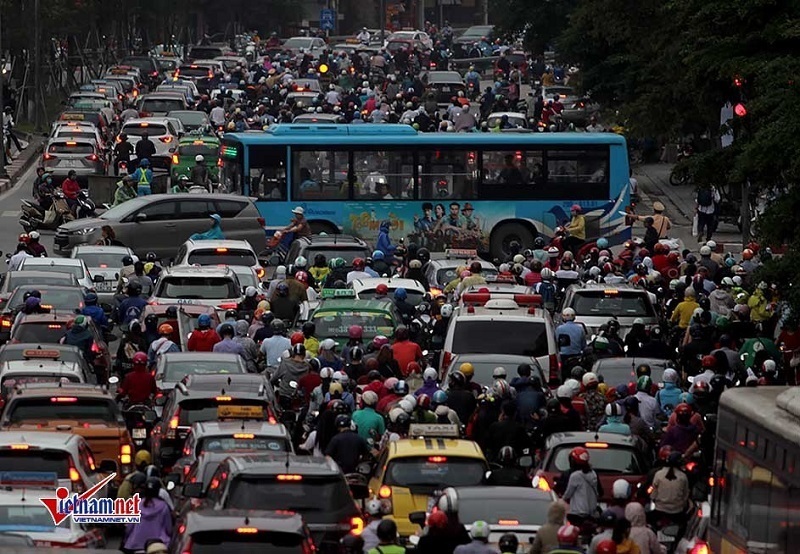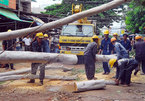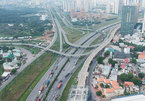Hanoi and HCM City residents feel this most clearly. In the morning, when leaving home to go to the office and school, and in the afternoon, when returning home, they have to struggle on the road with the flow of people and exhaust from cars and motorbikes.

In the summer sun, people are subjected to the scorching heat because of the asphalt effect, concrete houses, and the heat from air conditioners and engines. When it rains, people have to struggle because the roads turn into rivers and streams.
Most of the elderly do not have places for relaxation, while children have no place to play. When people feel tired, they need cool spaces to walk and rest in, but it is just a far-away dream.
The problem is difficult to settle, so people as well as the next generations will suffer.
What are the reasons behind this?
This is because of the existence of ‘interest groups’ in civil engineering. The urban development plan is unreasonable, and the plan is crushed according to the intentions of investors who seek profits for themselves.
A report from the National Assembly shows 1,400 plans which have been adjusted one to six times.
The adjustments were made to maximize the benefits for investors and minimize the areas for public interests: increasing the construction density, number of stories and floor areas, and decreasing the greenery area and the area for pavements, entertainment and infrastructure items.
Here are some examples in Hanoi, the green peaceful city.
| Those who ignore or collude with each other to shatter urban development planning not only make the lives of urban people increasingly confined and suffocated, but also jam development space for the future. |
The Trung Hoa – Nhan Chinh new urban area developed by Vinaconex became operational in 2006. In the first phase of operation, the urban area was considered a good example for Hanoi. But 10 years later, multi-story buildings have arisen continually and the population has increased rapidly, making the living space more cramped.
Under the 1/500 development plan of the urban area approved in 1998, the Trung Hoa – Nhan Chinh urban area had a building density of 34.88 percent, 8 buildings with 6-7 stories each.
Three years later, the plan was adjusted. It not only has 8, but 16 multi-story buildings as well and the height of each building increasef by twofold with 9-21 stories.
In the last 20 years, after a lot of adjustments, the building density of the new urban area has increased to over 50 percent, with 16 multi-story buildings with 17-34 stories each.
The Linh Dam urban area in Hoang Mai district is another typical example.
The construction began in 1997. It covered an area of 200 hectares, including 74 hectares of reservoirs and had the expected population of 25,000. In 2001, the construction was completed.
However, more and more multi-story buildings have been arising and the local population has increased to 70,000.
The building No 8B on Le Truc street, located in the central area of Hanoi, is another example.
The license for construction shows that the height of the construction work must not be higher than 53 meters. However, the real height after the construction was completed was 69 meters, or 16 meters higher, equal to five stories, than allowed.
The floor area as shown in the license is 30,000 square meters, but the investor built on 36,000 square meters.
Enterprises and administrative agencies have been removed from inner districts in order to increase the green space and the greenery area per capita, reduce the population density and mitigate environmental pollution.
However, wherever enterprises and administrative agencies move, multi-story apartments will spring up there, thus increasing the number of residents in these areas by dozens or even hundreds of times.
One of the most important goals when merging Ha Tay province with Hanoi was to create airy space for the capital city, but that goal has not been achieved. Not only the old urban districts of Hanoi, but newly established districts are also getting cramped.
Ha Dong district is a typical example. With the area of nearly 48 square kilometers, Ha Dong is the largest district in Hanoi. Within a short time, hundreds of residential quarters and dense multi-story buildings have arisen in close proximity, close to big roads.
Ha Dong's population in 2006 (before it was merged with Hanoi) was only 96,000, but it is now 350,000.
To Huu Road, which has been expanded, together with the Nguyen Trai Road, are two large major roads that link Ha Dong and the central area. But in the last few years, heavy traffic jams occur on the roads.
As the largest district in Hanoi, it has no park or outdoor entertainment area, except the Ha Dong Park with an area of several thousands of square meters, which was established a long time ago.
Who are the culprits who distorted the urban area development plan?
According to Tran Thu Hang, Director of the Department of Architectural Planning under the Ministry of Construction, the approval of detailed planning of the projects was made by the Hanoi People's Committee. Hanoi decided. The adjustment must be in accordance with urban planning and ensure transparency with the consent of the people.
As such, the legal entity which must take responsibility for the distortion of the urban planning are the leaders of different levels and appropriate agencies of Hanoi.
Why does this problem happen in Hanoi, a political, economic and cultural center? Because of the lack of officers?
The answer is ‘no’. A leader of the Ministry of Construction’s Inspection Agency said only half of the current 1,600 construction inspectors are needed to be in charge of programming and licensing construction works. If they worked with full responsibility and strictly handled violations right from the beginning, there would not be so many construction works that violate regulations.
It is clear that the distortion and crush of the urban development plan is the result of collusion between investors and officers, from local authorities to relevant ministries.
The noteworthy thing is that most of these officers are ‘safe and sound’ and they are not punished. Some officers have received sanctions, but they were only reprimanded, or they resigned from their posts. They mostly were charged with ‘lacking responsibility and loosening management’.
At National Assembly’s sessions, when deputies question the unreasonable urban planning, the Government members claim their responsibility and promise to settle the problems. The same thing is repeated all the time, but the problems continue toexist.
Nguyen Huy Vien

HCM City to identity trees best suited to urban areas
HCM City plans to conduct research and identify trees resilient to natural disasters and suited to the local soil.

HCM City encourages investment in Northwestern Urban Area
The HCM City Department of Planning and Architecture, after collecting feedback from local authorities, plans to ask the city People’s Committee to approve the zoning plan for the HCM City Northwestern Urban Area.
 Those who ignore or collude with each other to shatter urban development planning not only make the lives of urban people increasingly confined and suffocated, but also jam development space for the future.
Those who ignore or collude with each other to shatter urban development planning not only make the lives of urban people increasingly confined and suffocated, but also jam development space for the future.